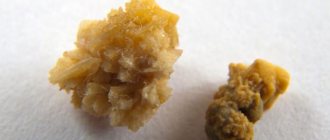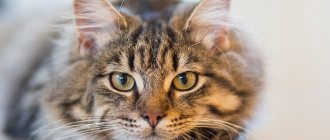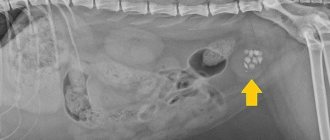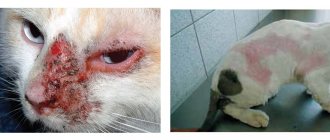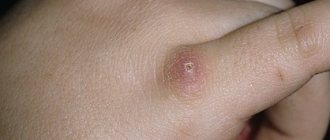Hyperparathyroidism in cats is a disease associated with a metabolic disorder (metabolic process), when calcium is washed out of bone tissue and enters the bloodstream. In accordance with the physiological norm, 99% of its volume is contained in the structures of the skeleton and tooth enamel, and the remaining 1% is present in the form of ions in the blood. With hyperparathyroidism, the balance is disrupted, which causes pathological changes in the body. Read more about the symptoms and treatment of this disease in our article.
Hyperparathyroidism in cats: symptoms and treatment
Hormones affecting calcium balance
The optimal amount of minerals in the blood, including calcium, is ensured by the action of hormones. One of these is parathyroid hormone, which is synthesized by the parathyroid organ. Under its influence, the calcium needed by the body is borrowed from the bones, and the kidneys begin to work to maximize the retention of these ions.
Mineral imbalance is followed by deterioration in well-being
The thyroid gland produces calcitonin, a specific hormone that has the opposite effect, thereby maintaining a healthy mineral balance. An incorrect balance can have detrimental consequences for your pet's health.
Reasons for the development of the disease
To establish the cause of the development of hyperfunction of the parathyroid gland in cats, it is important to understand how the activity of the gland itself is regulated. There is another regulator of calcium metabolism in the body - thyrocalcitonin, produced by the thyroid gland.
Both hormones are in proportional inverse relationship. When one increases, the production of the other active metabolite decreases, and vice versa.
The causes of the disease in cats include:
- Nutritional hyperparathyroidism in cats is a fairly common phenomenon.
- Genetic predisposition of the animal.
- An autoimmune reaction that causes increased hormone production by the parathyroid glands.
- Pathological immunity of receptors to parathyroid hormone in tissues and organs (renal parenchyma, osteoclasts) underlies secondary nutritional hyperparathyroidism in cats. Most often, such conditions develop under the influence of excessive background radiation.
Almost all pathological conditions are caused by damage to the thyroid gland, while the production of active hormone in the tissues of the gland reflexively increases.
What happens in the body when there is calcium deficiency?
Calcium deficiency leads to a decrease in its volume in the blood, which, in turn, stimulates the active production of parathyroid hormone. It promotes the active removal of the mineral from natural storage (i.e. skeletal bones) and its transfer into the blood to maintain its normal composition.
Phosphorus oversaturation occurs in cats that often eat fish.
In this case, the bones are destroyed without having time to recover. They become weak and fragile. When an animal's diet is oversaturated with phosphorus, the problem worsens, since this trace element (if there is too much of it) interferes with the normal absorption of calcium from the intestines.
Description example
Descriptive part: In the wings of the ilium and in the ischial bones on both sides, single homogeneous focal formations are identified, hyperintense by T2, T2stir, hypointense by T1 VI, relatively homogeneous structure, with clear, somewhat uneven contours, with signs of lytic destruction of the cortical layer of the inner surface of the left wing ilium, with the presence of a minimal soft tissue component in this area, ranging in size from ..x..x.. cm to ..x..x.. cm.
CONCLUSION: MR picture of the same type of focal changes in the ilium and ischium on both sides with signs of destruction of the cortical layer of the wing of the left ilium (may correspond to Brown tumors, as a manifestation of primary hyperparathyroidism).
Diet for a cat with hyperparathyroidism
The range of well-known food brands always includes products intended for animals with health problems.
Table. Ready-made food for animals with kidney pathology
| Name | Characteristic |
ADVANCE Cat Renal (Spain) | Therapeutic diet for cats with kidney disease. Complete and balanced composition for animals with poorly functioning kidneys and calcium deficiency. Prevents the formation of stones. Features low phosphorus content and high quality proteins |
| Hill's Feline j/d (USA) | Composition for cats with bone and joint problems. Normalizes their functionality in 1 month. Contains the optimal amount of nutrients, as well as beneficial omega-3 fatty acids |
| Royal Canin Mobility for cats and cats (France) | A complete product with chondroprotectors that improves the mobility of animal joints after injuries and operations, as well as for diseases of the musculoskeletal system |
| Pro Plan Veterinary Diets Feline NF Renal Function dry (Italy) | Medicinal composition for adult and old cats and cats, regardless of breed, all breeds with chronic renal failure and its complications |
| Pro Plan NF ST/OX RENAL FUNCTION (Italy) | Ready-made food for cats containing a small amount of dietary phosphate. Inhibits the development of renal failure and significantly reduces the incidence of secondary hyperparathyroidism |
It is important to understand that:
- in the fight against hyperparathyroidism and its manifestations, diet has medicinal value, which means it must be selected individually;
The diet for hyperparathyroidism is developed with the participation of a veterinarian
- some formulations are intended for constant feeding, others should be given for a limited time and in strictly defined quantities;
- There are therapeutic foods that are sold by prescription. But, even if the product can be purchased freely, its use should be previously agreed with a veterinarian.
The needs for minerals and other important components are different between young and old cats. When choosing a ready-made diet for a sick animal, you should take into account its age.
Diagnostic procedures
If such an illness is suspected, the furry puppy should see a doctor as soon as possible.
The sooner owners detect hyperparathyroidism in kittens and contact a veterinary clinic, the higher the chances of a favorable outcome and prevention of many complications. The specialist must clarify the pet’s diet and conduct a visual inspection. To detect hypoparathyroidism, your veterinarian will order x-rays for cats. If the symptoms of the disease appear due to dysfunction of the endocrine system, then the kitten’s bones in the pictures are almost transparent, the spinal column is curved and several small fractures are observed. After diagnosis, the specialist will tell you how and how much to treat the cat. The selection of a therapeutic course is influenced not only by the degree of hyperparathyroidism, but also by the age of the kitten and its general condition.
Consequences of hyperparathyroidism
This pathology rarely goes away without a trace for the animal. Common consequences include:
- disturbances in the functioning of the central nervous system if the spine is deformed. They are expressed by paralysis and paresis, difficulties with bowel movements, urinary incontinence;
Urinary incontinence can become chronic
- curvature of the limbs, making the animal’s movement uncomfortable and painful;
- deformations of the pelvic bones and chest, which negatively affects the functioning of the cardiovascular, respiratory, digestive and genitourinary systems;
- dental problems;
Caries, pulpitis and even tooth loss are common in cats suffering from calcium deficiency.
- slow growth of the animal.
The earlier hyperparathyroidism is detected and the sooner treatment is started, the greater the cat’s chances of full recovery.
Laboratory diagnostic methods
When examining the urine of animals suffering from hyperparathyroidism, a slight decrease in calcium levels is noted. The amount of phosphorus in the blood and urine does not deviate from the norm. Changes indicating reduced skeletal mineralization are detected only in advanced stages of the disease.
X-rays are used to confirm or refute the diagnosis. The bones of sick animals in the photographs look transparent, have thinned walls, and low density. The boundaries between soft tissues and bones are erased, and already healed fractures can be detected.
X-rays help assess the degree of bone deformation. The prognosis for a successful recovery is made based on the condition of the spine, thoracic and pelvic bones.
Cats with neurological disorders are carefully examined for spinal injuries. The pictures may show cracks, curvatures, deformation of the vertebrae, and hernias.
If an X-ray examination reveals a full intestine or bladder, the animal is given immediate assistance.
To obtain high-quality x-rays, the pet must remain motionless for several minutes, which causes difficulties during this procedure. If, due to severe pain and anxiety, the cat does not want to lie still, you need to be patient and calm the animal. The effectiveness of further treatment largely depends on the quality of the images obtained and the accurate diagnosis.
Prevention
To protect your pet from hormonal pathology, which can lead to irreversible consequences, you must:
- take care of his proper nutrition, the best option for which would be the use of balanced ready-made feed;
The best option for a cured pet would be specialized premium food.
- Periodically show your cat to a veterinarian in order to have objective information about the state of its health, and, if necessary, also receive professional advice on diet and maintenance.
Prevention is the simplest and most inexpensive way to protect an animal from diseases and prolong its life. Owners of pets with hyperparathyroidism should take note of a balanced diet, which will help protect their pet from an excess of a particular substance in the body.
Natural cat diet
Treatment: basic methods
Sometimes fluffies are prescribed the drug Miacalcic.
If a cat exhibits symptoms of primary hyperparathyroidism associated with impaired functioning of the parathyroid glands, then the main therapy is surgical removal of the adenoma. After surgery, the calcium level often decreases, so the pet remains in the hospital for the first 24 hours so that veterinarians monitor its condition. If bone depletion in adult cats is associated with an unbalanced diet, then special foods are selected that contain a small amount of phosphorus. Treatment of kittens with hyperparathyroidism also involves adjusting the daily diet. Veterinarians recommend choosing specialized foods for babies that contain a balanced level of all the microelements and vitamins necessary for a growing body. It is equally important to reduce the motor activity of a kitten with hyperparathyroidism, especially if an advanced form of rickets is detected. In this case, it is recommended to place the pet in a small container with soft walls and keep it there for 7-14 days. For special indications, the cat is prescribed medications containing calcium, such as:
- "Calcium gluconate 10%";
- "Miacalcic";
- "Calcitonin".
List of used literature and sources
- Brown tumors [Electronic resource] / Dr Hani Salam. – 2010. – Access mode: https://radiopaedia.org/cases/brown-tumours – Access to the source: 04/05/2018
- Dedov I.I. Primary hyperparathyroidism: clinical picture, diagnosis, differential diagnosis, treatment methods [Electronic resource] / I.I. Dedov, G.A. Melnichenko, N.G. Mokrysheva, L.Ya. Rozhinskaya // Journal. Problems of endocrinology. – 2016. – T. 62, No. 6. – P. 40-77. – Access mode: https://www.mediasphera.ru/issues/problemy-endokrinologii/2016/6/1037596602016061040 (access date: 04/05/2018).
- Diagnosis of hyperparathyroidism on MRI and CT images of bones [Electronic resource] – Access mode: https://mritest.ru/article/Ortopedija/Metabolicheskie_naru/ Giperparatireoz – Access to the source: 04/05/2018
- Primary hyperparathyroidism [Electronic resource] / Dreval A.V. – 05/06/2015. – 427s. Access mode: https://www.rmj.ru/articles/endokrinologiya/Pervichnyy_giperparatireoz/ - Access to the source: 04/05/2018

